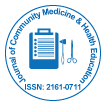Empowering Community Health through Nursing Interventions
Received: 07-Mar-2025 / Manuscript No. jcmhe-25-167362 / Editor assigned: 10-Mar-2025 / PreQC No. jcmhe-25-167362 (PQ) / Reviewed: 24-Mar-2025 / QC No. jcmhe-25-167362 / Revised: 31-Mar-2025 / Manuscript No. jcmhe-25-167362 (R) / Published Date: 07-Apr-2025
Description
Highlighting the value of community health nursing as a central component of primary care delivery. As nations grapple with the dual challenges of rising chronic disease burdens and the need for equitable access to healthcare, the establishment of community health nursing systems provides a vital solution. In newly established systems, the effectiveness of this model largely hinges on how nursing interventions are designed, implemented and integrated into existing public health frameworks. These interventions are not merely extensions of clinical services into community settings; they represent a change toward proactive, preventive and person-centered care.
Nursing interventions in this context must be tailored to the specific social, economic and epidemiological realities of the communities they serve. In a newly established system, one of the foundational responsibilities of community health nurses is conducting comprehensive assessments to identify local health needs. These assessments go beyond clinical screenings and include evaluations of housing conditions, access to nutritious food, social support networks, environmental exposures and prevailing health beliefs. This initial mapping allows for the design of targeted interventions that address the root causes of illness rather than just treating symptoms.
One of the most impactful nursing interventions in community health is health education. Community health nurses play a critical role in demystifying medical information, correcting misconceptions and promoting self-care practices. Whether addressing chronic diseases like diabetes and hypertension, infectious disease prevention, maternal and child health, or mental well-being, effective health education empowers individuals to take charge of their health. In newly established systems, these interventions must be adapted to the cultural and literacy levels of the community. Nurses often serve as translators of medical knowledge, ensuring that health promotion messages are relevant, accessible and actionable.
Immunization programs are another area where community health nursing interventions are vital. In settings where health infrastructure is still being built, community nurses often lead efforts to organize vaccination drives, maintain cold chain logistics and track immunization records. Their direct interaction with families also allows them to address vaccine hesitancy, a growing concern in many parts of the world. In newly formed systems, the visibility and trustworthiness of nurses are essential assets in promoting public health measures that require high levels of community participation.
Chronic disease management, a growing concern worldwide, is particularly suited to community-based nursing interventions. In newly operational systems, community nurses can provide home visits to monitor blood pressure, blood glucose levels and medication adherence, particularly for elderly or mobility-limited patients. These interventions reduce hospital visits and improve health outcomes through consistent, personalized care. Importantly, this continuity builds therapeutic relationships that foster trust and adherence—critical factors in any long-term care plan.
Another cornerstone of effective community health nursing is mental health support. In many communities, especially those with newly developing health systems, mental health remains stigmatized and under-resourced. Nurses can serve as first points of contact for individuals experiencing stress, depression, or trauma. Through basic screening tools, crisis intervention strategies and referrals to specialized services, community nurses fill an essential gap in mental healthcare access. Training community health nurses in mental health first aid and trauma-informed care should be a priority in the early development stages of such systems.
Maternal and child health is another area where nursing interventions yield profound impact. From prenatal visits and nutritional counseling to postnatal monitoring and infant growth tracking, nurses ensure continuity of care for mothers and newborns. In newly established systems where maternal mortality may still be a challenge, community health nurses are instrumental in educating women about birth preparedness, warning signs of complications and the importance of facility-based deliveries. Furthermore, they can coordinate care with midwives and physicians, ensuring a smooth transition from community to clinical settings when needed.
A particularly innovative role for community health nurses is in health surveillance and early outbreak detection. Because they are embedded in the community and often visit homes regularly, they are ideally positioned to detect patterns of illness that may indicate emerging public health threats. Their reports can help guide responses to disease outbreaks, ensuring timely intervention before wider spread occurs. This function is especially critical in rural or underserved areas where health information systems are still developing.
In conclusion, nursing interventions in newly established community health systems are not just a technical or logistical necessity— they are a transformative opportunity. By extending care beyond hospital walls and engaging with individuals where they live, work and age, community nurses can redefine health from a reactive service to a proactive partnership. For this vision to be realized there must be strong institutional commitment to training, supporting and integrating community health nurses within the national health strategy. Done well, these interventions can lay the foundation for more equitable, efficient and people-centered health systems around the world.
Citation: Romero I. (2025) Empowering Community Health through Nursing Interventions. J Community Med Health Educ 15:927.
Copyright: © 2025 Romero I. This is an open-access article distributed under the terms of the Creative Commons Attribution License, which permits restricted use, distribution, and reproduction in any medium, provided the original author and source are credited.
Select your language of interest to view the total content in your interested language
Share This Article
Recommended Journals
Open Access Journals
Article Usage
- Total views: 442
- [From(publication date): 0-0 - Dec 15, 2025]
- Breakdown by view type
- HTML page views: 350
- PDF downloads: 92
